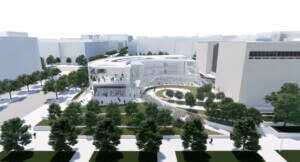MARABAR, a million-pound split-rock sculpture by American artist Elyn Zimmerman, has been turning heads at National Geographic Society (NGS) headquarters in Washington, D.C. since 1984. Anchoring a sweeping modernist plaza designed by David Childs of SOM in collaboration with landscape architect James Urban at the NGS campus on 17th and M Streets NW, MARABAR is comprised of a long and narrow reflecting pool flanked by five massive mahogany boulders.
The work is as site-specific as it gets, which is why its potential erasure as part of a planned overhaul led by D.C.-based Hickock Cole prompted such outrage and swiftly landed the sculpture on The Cultural Landscape Foundation (TCLF)’s Landslide index of under-threat landscapes of cultural significance in March of 2020.
Fast-forwarding nearly two years after dozens of letters of support and one game-changing resolution later, it has been announced that MARABAR will be relocated roughly four miles away to the campus of American University where it will be reinstalled in a new configuration opposite the Katzen Arts Center. Reporting for the New York Times, Rebecca J. Ritzel first broke news earlier this week of the newly established agreement between American University and the NGS, the latter of which will foot the bill for the process.
“It’s a piece that’s part of the history of landscape architecture,” Jack Rasmussen, director of the American University Museum, explained to the Times. “A woman sculptor in the 1970s and 1980s who was doing this? It’s ground breaking.”
Per the resolution established in March 2021 after D.C.’s Historic Preservation Review Board (HPRB) was urged via a TCLF-led campaign to revisit the unanimous August 2019 vote that permitted NGS to move ahead with its MARABAR-less renovation plans, Zimmerman’s work would be spared from removal and/or relocation within the revamped plaza and instead be reinstalled at a then-yet-to-be-determined new location at the expense of the NGS.
As outlined in the resolution, Zimmerman would be actively involved in selecting a “cultural institution or another appropriate site” for MARABAR.
A scrapped plan pitched by the NGS prior to the resolution would have seen MARABAR relocated to Washington Canal Park in southeast D.C. That scheme was opposed by both Zimmerman and landscape architect Dave Rubin, who designed Washington Canal Park while an equity partner at OLIN.
“I have been assured by NGS that I will have an active role in overseeing the removal, transportation and eventual installation of the components of MARABAR on a new site which will be carried out at National Geographic expense,” explained Zimmerman in a statement released shortly after the resolution was formalized back in March. “I am deeply grateful to The Cultural Landscape Foundation for bringing attention to the issue of MARABAR’s pending demolition to the HPRB last year.”
While TCLF was responsible for first sounding the alarm over the imperiled status of MARABAR, Charles Birnbaum, president and CEO of the D.C.-based advocacy- and education-focused nonprofit, stressed to AN that it was a chorus of diverse and prominent voices that got the job done and saved the sculpture from an uncertain fate lacking the input of Zimmerman.
“In the campaign to save MARABAR, there was a convergence of influential voices from many disciplines assembled by TCLF – museum directors, curators, artists, landscape architects, historians, architects and others, including a Nobel Prize-winning scientist – that was powerful, persuasive and effective,” he said in an emailed statement.
As previously reported, those who submitted letters of opposition to the HPRB included, among others, New Yorker writer Adam Gopnik, architect Frederick Fisher, artist and designer Mary Miss, architectural historian and critic Marc Treib, and Childs himself.
In his letter, Childs urged the board to “preserve her [Zimmerman’s] sculpture as part of whatever modifications are being contemplated.”
Of course, those letters were part of a campaign to leave MARBAR be and preserve it in situ within the site that Zimmerman had specifically designed it for nearly 40 years ago. That obviously did not pan out.
“I’m glad it will still be in Washington,” Zimmerman told the Times, adding that MARABAR’s lanky, rectangular water feature will be reworked into a crescent shape at its new location at American University. She also revealed that once MARABAR begins its second chapter at its new home (a perhaps more publicly visible one near busy Ward Circle, as the Times points out), it will cease being MARABAR.
“It will be something new,” she said.
Excavation of the massive sculptural installation commenced earlier this month at NGS headquarters. Installation work at American University is slated for next summer.











